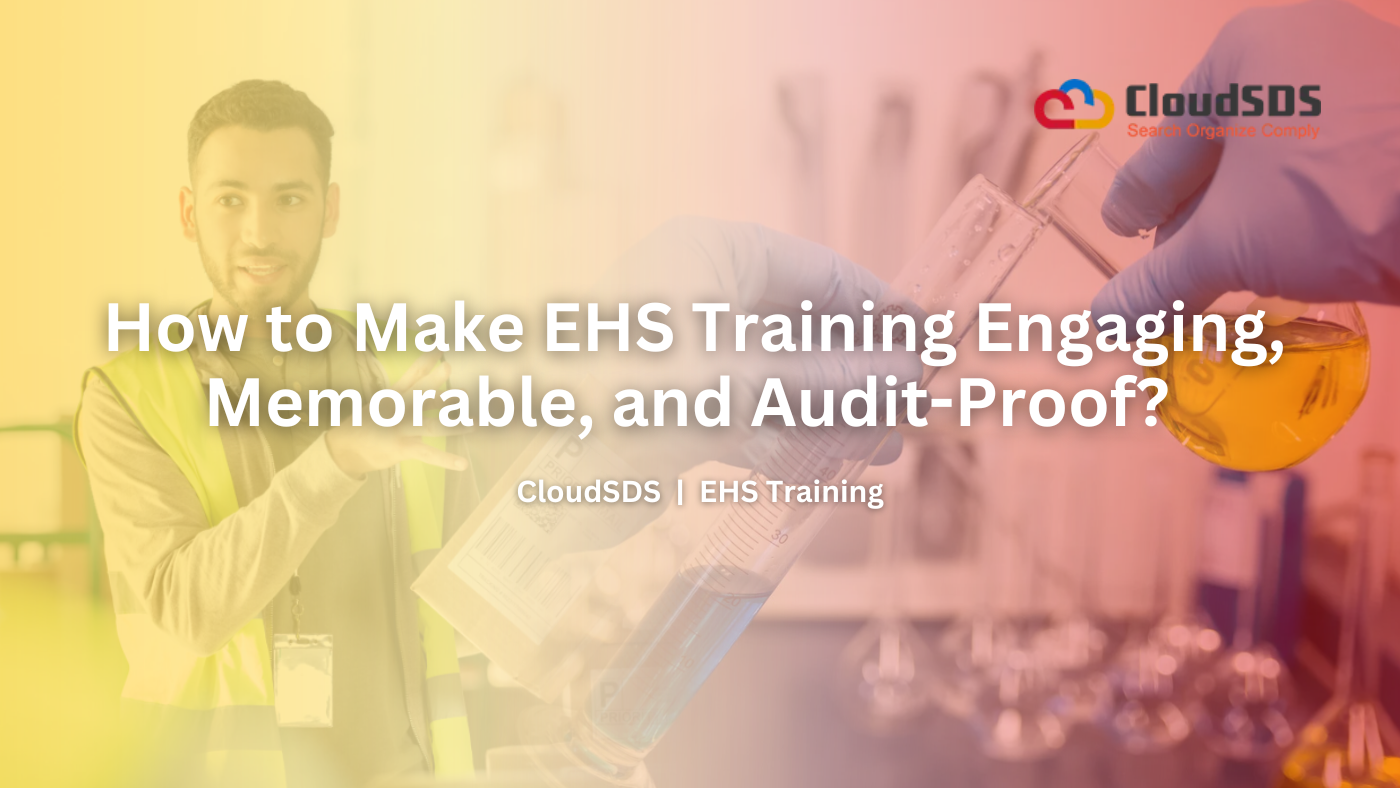Delivering Environmental, Health, and Safety (EHS) training often comes with a common challenge: employees tend to see it as dull, repetitive, or simply a box to check. But if training fails to engage, it fails to protect. Ineffective programs not only weaken knowledge retention but also increase risks for both employees and the organization. At the same time, training must go beyond engagement. It should be compliance-ready to ensure your workplace remains audit-proof.
So, how do you design EHS training that employees remember, enjoy, and that stands strong during audits? Let’s break it down step by step.
What is an EHS Training Process and its Requirements?
The EHS (Environmental, Health, and Safety) training process is designed to help employees work safely, protect the environment, and stay compliant with regulations. Put simply, it ensures that everyone understands the hazards related to their jobs, the potential health and safety risks from those hazards, and the correct practices to follow to minimize them. It also teaches employees how to carry out their tasks in line with workplace procedures and environmental protection standards. Generally, an effective EHS training policy is built around the organization’s operational needs. Moreover, it needs to ensure that all the processes meet state, federal, and ES&H (Environment, Safety & Health) requirements.
Key Requirements of EHS Training Include:
1. Relevance:
Training should be directly connected to the employee’s specific role and responsibilities. For example, a lab worker handling chemicals needs detailed guidance on safe storage, labeling, and spill response. On the other hand, someone in administration may only require basic awareness. Clearly, role-specific training is required. It ensures that employees receive the knowledge that matters most in their daily work. Naturally, the process becomes more effective and engaging.
2. Compliance:
Every EHS training program must align with laws and industry regulations such as OSHA, EPA, or REACH. These standards are put in place to protect workers, the environment, and the public. By following them closely, organizations can avoid costly fines, reduce liability, and show that safety is a top priority.
3. Documentation:
Keeping detailed records of who was trained, when, and what was covered is vital. Documentation not only helps track employee progress but also serves as proof of compliance during audits or inspections. Most importantly, without proper records, even well-conducted training may not stand up in front of regulators.
4. Regular Updates:
Safety risks and regulations change over time. So, training cannot be a one-time event. Regular refreshers help reinforce important information, while updated modules keep employees informed about new hazards, procedures, or legal requirements. Ongoing training ensures safety knowledge stays fresh and relevant across the organization.
Why does EHS Training often Fail?
Before we explore solutions, let’s look at the common reasons why EHS training doesn’t work:
-
One-size-fits-all Content:
Training modules often ignore differences in job roles, exposure levels, or learning styles.
-
Overload of Compliance Language:
Regulations are important, but too much legal jargon makes employees tune out.
-
Passive Learning Methods:
Long slide decks and endless lectures don’t encourage active participation.
-
Lack of Follow-up:
Employees forget 70% of new information within 24 hours if it isn’t reinforced.
-
Poor Documentation:
Even if training was effective, if records aren’t audit-ready, compliance failures can occur.
The solution? A balance of engagement, retention, and compliance-proofing.
How to Make EHS Training Engaging?
Employees learn better when they feel involved. Here are some strategies to grab attention and keep it:
✔ Use Real-Life Scenarios
Instead of abstract rules, use case studies from your own workplace or well-known industry incidents. For example, walk employees through how a chemical spill happened, what went wrong, and how proper training could have prevented it.
✔ Gamify the Experience
Introduce quizzes, interactive simulations, or “safety challenges.” Gamification not only boosts participation but also helps learners retain critical safety practices.
✔ Role-Based Training
Tailor training for different job functions. A lab technician handling hazardous chemicals needs different training than someone in administration. Customized modules ensure relevance and effectiveness.
✔ Encourage Discussion
Turn lectures into conversations. Ask employees to share near-miss experiences or safety concerns—it makes training relatable and personal.
How to Make EHS Training Audit Proof?
Even the most engaging training fails if it cannot stand up to regulatory scrutiny. Compliance is non-negotiable, especially for organizations handling chemicals. Here’s what you can do:
✔️Keep Accurate Records
Use digital tools or Learning Management Systems (LMS) to log who attended, when, and what modules they completed. Automated reminders for retraining ensure nothing slips through the cracks.
✔️Align with Regulations
OSHA, EPA, REACH, and other standards have specific training requirements. Build your program around these and clearly document which regulation each training module addresses.
✔️Standardize Content across Sites
For organizations with multiple facilities, consistency is key. Ensure training materials are uniform while allowing for site-specific customization.
✔️Regularly Update Training
Chemicals, equipment, and regulations change. So, your training process and course should be updated. Review and refresh modules annually or sooner if new hazards emerge.
✔️Ensure SCORM Compliance
To make your EHS training audit-proof, it’s essential to design courses that are SCORM compliant (Sharable Content Object Reference Model). SCORM is a widely accepted standard that ensures your training modules can work across different Learning Management Systems (LMS).
Conclusion
EHS training is more than a regulatory requirement. It’s the foundation of a safer, more resilient workplace. When designed to be engaging, memorable, and audit-proof, it becomes a tool that not only meets compliance standards but also inspires employees to take safety seriously. For organizations that handle chemicals, the right training can mean the difference between avoiding accidents and facing costly consequences.
By choosing an effective EHS training, you’re not just checking a compliance box. Rather, you’re protecting your people, your operations, and your reputation while building a culture of safety and trust.

Leave A Comment